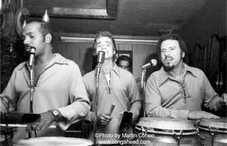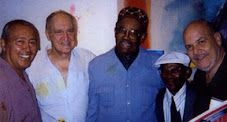
At the turn of the century, Asbury Park and Sarasota Springs were the gambling meccas of the northeast. The Depression put an end to their heydays. An attempt was made to place gambling on the Jersey Shore at Long Branch. The Rumba Casino, where I worked with the Tony (Nino) Yacavino troupe, was chosen as an experiment to see if it could offer gamblers what they needed. Jimmy Pellecchia was the owner and Harry Kilby was the front man. Harry booked the shows together with his wife and daughter, who came down from New York. Jimmy was boxing commissioner of New Jersey, and Nino had been a boxer before becoming an accomplished dancer.
Similarly, in Miami Beach, Lou Tendler, a champion boxer from Philadelphia, was part owner of the Carrousel Club, with its revolving bar and air-conditioning in 1940. I caught pneumonia dancing and sweating, due to it, and my colleague Pepito became very ill as well. We were not accustomed to it, and Pepito used to stand with his back to a large fan during rehearsal breaks. I also suffered severe hearing loss partially due to the blasting trumpets just behind me as I performed night after night. We liked our music loud even then, I guess.
Gambling interests figured that Asbury Park would be a more suitable location but that didn’t take off, and of course today you have them at Atlantic City. 1952 found me on a 90-day round-the-world cruise, escorting 17 Brazilian millionaires. One of the passengers on the ship was Filipino who owned the Manila Herald and the Jai Lai Fronton. He persuaded me and my ex-wife to perform after seeing us giving dance lessons during the trip.
For the many years spent on ships, the Champagne Hour was one of my favorite evenings, when I MC’d the show. Passengers could chose their own dance selections and a bottle was awarded in each category. We did the conga line bit to begin each sailing, off with a big happy start to the cruise…and did it at the last night as well. On the S.S. Oceanic, we had four bands which were placed at intervals among the participants (which meant everyone aboard, just about). Going from salon to salon, one would hear different orchestras overlapping, as was the case in Havana at the Palacio Gallego, on different floors of the building.
In 1940, the danzon was the most played style, except at the sidewalk cafes in front of the Capitolio, where bands like Anacaona played mostly rumba. Here again, the music would overlap since the bands were adjacent to each other. In the afternoons, along the Malecon, there were small bars indoors that had 3 or 4 musicians playing on concrete floors for dancers. Rum was cheap and the dancers were poor, but happy, made so by the combination of two sweet forces at work.
Sunday mornings we went to the Bosques de Almendares to drink and dance, and some to swim, later. We also rode horses in the cool of the early morning, at El Encanto. The perfume wafted out into Calle Nettuno (or was it Calle Luna?). Havana was a rare mix, a garden of earthly delights, which was irresistible to all…a conspiracy of seductive temptations. It was as though one had been imprisoned all his life, and suddenly released in a gay and friendly world…so unlike anywhere else on earth. To bring the Cuban spirit to the rest of the world by means of its music is today a mission of mercy to a beset planet.


1 comment:
Harry Kilby was my grandfather. I remember him very well and as a tribute to his legacy, I am researching our family history. I would appreciate any help and information about him, my grandmother, Nancy Kilby, and my mother, Edna Kilby Ramirez.
Post a Comment